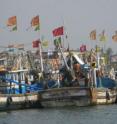Algal blooms hit the poor of India hard
Related images
(click to enlarge)
The problem of toxic algae is not just confined to the Nordic countries – in India algal blooms are threatening poor people's access to food and their livelihoods, a problem that has been exacerbated by global warming. With funding from the Swedish Research Council for Environment, Agricultural Sciences and Spatial Planning and the Swedish International Development Cooperation Agency, researchers from the University of Gothenburg are to attempt to reduce the effects of algal blooms. As in many other developing countries near the equator, millions of people in India depend on the sea as a source of income and food. Exports of farmed tiger prawns and other aquatic organisms are an important part of the Indian economy, and mussels and oysters are often the main source of protein for many poor people.
Environmentally harmful chemicals
But marine farming in India is beset with problems. When pathogenic bacteria, viruses and toxic algae attack, the farmed prawns are treated with antibiotics, which results in resistance. It is also common for the water in the aquaculture ponds to be treated with environmentally harmful chemicals.
Studying the effects
Global warming is predicted to make harmful algal blooms larger and more numerous, as higher temperatures lead to more precipitation and a greater run-off of nutrient salts into the marine environment. The south-west coast of India is particularly exposed in this respect, and it is here that a research project from the University of Gothenburg is to monitor the impact of climate change on algal blooms, with funding from the Swedish Research Council for Environment, Agricultural Sciences and Spatial Planning.
Environmentally friendly food
The background is that the Indian authorities are investing heavily in developing mussel and oyster farms in the hope that they will be able to increase export revenue and produce an environmentally friendly, protein-rich food for the country's sizeable population. Systematic monitoring that can predict when and where algal blooms will occur is needed if the investment is to pay off.
Future blooms
Using their own investigations and material from Indian colleagues, Anna Godhe and her team at the Department of Marine Ecology will study how the phytoplankton has changed over the last 50 years – a period when the surface water temperature of the Indian Ocean has risen by 1.5 degrees.
"We want to find out which species are expected to cause future blooms, so that we can see how monitoring can be made more efficient," says Godhe. "We will also be producing models showing how climate change affects tropical ecosystems, something that has only been done to a very limited extent before."
Less aid
"I think our research is important, not least because India's strong growth has meant that aid has been scaled down, at the same time as we have realised that environmental problems extend beyond national borders and are worried that everyone in India will get a car and a fridge. We forget that this is a country that is grappling with enormous infrastructure problems, and that more than 700 million people live on less than a dollar a day."
Source: University of Gothenburg
Other sources
- Algal blooms hit the poor of India hardfrom PhysorgTue, 1 Jun 2010, 14:21:28 UTC
- Algal blooms hit the poor of India hardfrom Science DailyMon, 31 May 2010, 16:31:56 UTC


